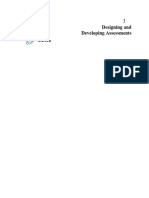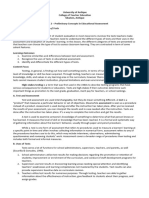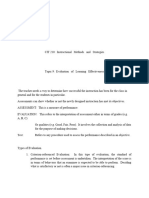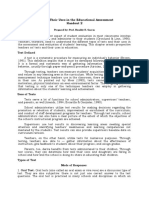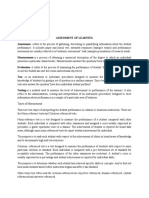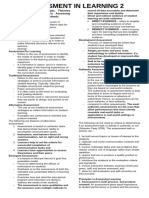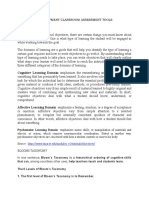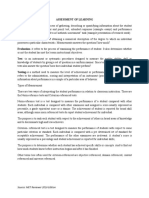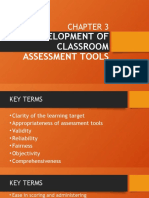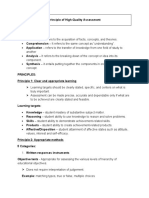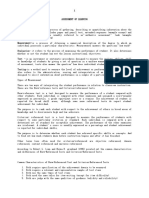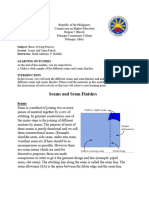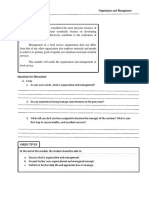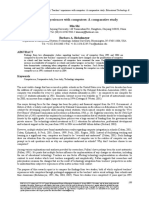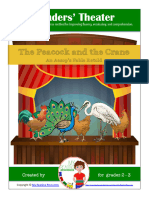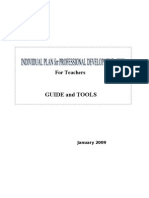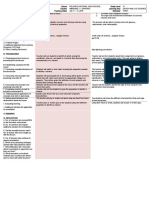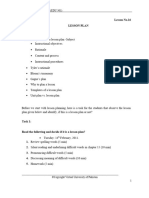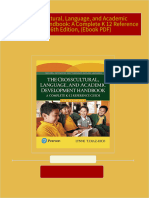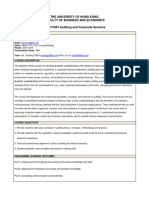Principles of High Quality Assessment
Principles of High Quality Assessment
Uploaded by
Mark Anthony Nieva RafalloCopyright:
Available Formats
Principles of High Quality Assessment
Principles of High Quality Assessment
Uploaded by
Mark Anthony Nieva RafalloCopyright
Available Formats
Share this document
Did you find this document useful?
Is this content inappropriate?
Copyright:
Available Formats
Principles of High Quality Assessment
Principles of High Quality Assessment
Uploaded by
Mark Anthony Nieva RafalloCopyright:
Available Formats
Principles of High Quality Assessment
Teacher made tests are developed by a classroom teacher to assess the learning
progress of the students within the classroom. It has weaknesses and strengths. The strengths
of the teacher-made test lie on its applicability and relevance in the setting where they are
utilized. The weaknesses are the limited time and resources for the teacher to utilize the test
and also some of the technicalities involved in the development of the assessment tools.
Most literatures considered the most common technical concepts in assessment are the
validity and reliability. For any type of assessment, whether traditional or authentic, it should
be carefully developed so that it may serves whether purpose it is intended for and the test
results must be consistent with the type of assessment that will utilized.
Clarity of the target
The learning outcome must be (SMART) Specific, measurable, attainable, realistic and
time-bound.
1. Objective Test- It is a type of test that requires students to select the correct answer
a question or complete a statement. The word objective refers to the scoring, it
indicates that there is only one correct answer.
2. Subjective Test- it is a type of test that permits the student to organize and present
an original answer. This type of test has no specific answer. It is usually scored on
opinion basis.
3. Performance Assessment- is an assessment in which students are asked to perform
real world task that demonstrate meaningful application of essential knowledge and
skills. It can appropriately measure learning objectives which focus on the ability of
the students to demonstrate skills or knowledge in a real-life situation.
4. Portfolio Assessment- it is an assessment that is based on the systematic,
longitudinal collection of students work created in response to specific, known
instructional objectives and evaluated in relation to the same criteria. It is a
purposeful collection of student’s works that exhibits the student’s efforts, progress
and achievements in one or more areas over a period of time.
5. Oral Questioning- this method is used to collect assessment data by asking oral
questions. The most commonly used of all forms of assessment in class assuming
that the learners hears and shares the used of common language with the teacher
during instruction. The ability of the students to communicate orally is a very
relevant to this type of assessment. This also form of formative assessment.
6. Observation Technique- another method of collecting assessment data is through
observation. The teacher will observe how students carry out certain activities either
observing the process or product.
There are 2 types of observation techniques:
a. Formal observation – are planned in advance like when the teacher assess
oral report or presentation in class.
b. Informal observation - is done spontaneously, during instruction like
observing the working behavior of students while performing a laboratory
experiment in biology class and the like.
The behavior of the students involved in his performance during
instruction is systematically monitored, described, classified and
analyzed.
7. Self-report- the response of the students may be used to evaluate both
performance and attitude. Assessment tools could include sentence completion,
likert scales, checklists, or holistic scale.
DIFFERENT QUALITIES OF ASSESSMENT TOOLS
1. VALIDITY -refers to appropriateness of score-based inferences; or decisions made based on
the students test results. The extent to which a test measures what it is supposed to measure.
2. RELIABILITY-refers to the consistency of measurement; that is, how consistent test results or
other assessment results from one measurement to another. We can say that a test is reliable
when it can be used to predict practically the same scores when test administered twice to the
same group of students and with a reliability index of 0.61 above.
3. FAIRNESS-means the test item should not have any biases. It should not be offensive to any
examinee subgroup. A test can only be good if is fair to all the examinees.
4. OBJECTIVITY-refers to the agreement of two or more raters or test administrators
concerning the score of the students. If the two raters who assess the same students on the
same test cannot agree on the score, the test lacks objectivity and neither of the score from the
judges is valid. Lack of objectivity reduces test validity in the same way that the lack of reliability
influence validity.
5. SCORABILITY-means that the test should be easy to score, direction for scoring should be
clearly stated in the instruction. Provide the students an answer sheet and the answer key for
the one who will check the test.
6. ADEQUACY-means that the test should contain a wide range sampling of items to determine
the educational outcome or abilities so that the resulting scores are representatives of the total
performance in the areas measured.
7. ADMINISTRABILITY-means that the test should be administered uniformly to all students so
that the scores obtained will not vary due to factors other than differences of student's
knowledge and skills. There should be a clear provision for the students; proctors and even the
one who will be check the test or the test scorer.
8. PRACTICALLY AND EFFECIENCY-refers to the teachers familiarity with the methods used,
time required for the assessment, complexity of the administration, ease of scoring, ease of
interpretation of the test results and the materials used must be at lowest cost.
Rafallo, Mark Anthony N.
Reporters: Basabe, Jeffrey T.
You might also like
- Basic Concepts in Assessment - NotesDocument6 pagesBasic Concepts in Assessment - NotesLeonard Finez71% (17)
- IELTS ReadingDocument8 pagesIELTS ReadingHernan ReyesNo ratings yet
- General Principles of TestingDocument32 pagesGeneral Principles of Testingrcherry calaor100% (10)
- Properties of Assessment MethodsDocument19 pagesProperties of Assessment MethodsCharles Magpili100% (5)
- Module 6 (Finals)Document6 pagesModule 6 (Finals)Mark Anthony Nieva Rafallo0% (1)
- Title Canteen Manager: Position DescriptionDocument3 pagesTitle Canteen Manager: Position DescriptionMark Anthony Nieva Rafallo100% (4)
- Marriage and Family Relationships (Module 1)Document10 pagesMarriage and Family Relationships (Module 1)Mark Anthony Nieva RafalloNo ratings yet
- 2nd Grade Social StudiesDocument4 pages2nd Grade Social Studiesapi-284814564No ratings yet
- Lesson Plans 8608 2021Document108 pagesLesson Plans 8608 2021Saima WaheedNo ratings yet
- Academic Behavior Checklist Student: Grade:: Poor Fair Good N.ODocument2 pagesAcademic Behavior Checklist Student: Grade:: Poor Fair Good N.OJoy Napier100% (2)
- English For Specific PurposesDocument7 pagesEnglish For Specific PurposesEmenheil Earl EdulsaNo ratings yet
- Module 3Document24 pagesModule 3PELINA, Carlos Jade L.100% (1)
- Module Assessment 3 - 020535Document29 pagesModule Assessment 3 - 020535Daniel EstopaceNo ratings yet
- Module 4 lESSONS 1 and 2 - DESIGNING AND DEVELOPING ASSESSMENT TOOLSDocument37 pagesModule 4 lESSONS 1 and 2 - DESIGNING AND DEVELOPING ASSESSMENT TOOLS•ᴍᴇssɪ•No ratings yet
- Module 4 CHAPTER 4 DESIGNING AND DEVELOPING ASSESSMENT TOOLSDocument7 pagesModule 4 CHAPTER 4 DESIGNING AND DEVELOPING ASSESSMENT TOOLSHannah PaceteNo ratings yet
- EDUC 4 Lesson 4Document9 pagesEDUC 4 Lesson 4Jeru ElbanbuenaNo ratings yet
- General Principles of TestingDocument3 pagesGeneral Principles of Testingdj choo100% (1)
- Chapter 3Document26 pagesChapter 3mmlgatus23No ratings yet
- AssessmentDocument30 pagesAssessmentWen PamanilayNo ratings yet
- Lecture Notes 3 - Assessment in Learning 1Document16 pagesLecture Notes 3 - Assessment in Learning 1Arailah L. ArafatNo ratings yet
- The Meaning & Importance of Evaluation (Lesson Planning) Beed 17Document5 pagesThe Meaning & Importance of Evaluation (Lesson Planning) Beed 17Arcel SorianoNo ratings yet
- Learning Assessment 1Document43 pagesLearning Assessment 1Christine Joy Dela Cruz100% (1)
- Lyksss Portfolio Kemerut 20240604 154541 0000Document20 pagesLyksss Portfolio Kemerut 20240604 154541 0000Lyka mae MelegritoNo ratings yet
- Module 2 - Lesson 3 Types and Distinctions of TestsDocument4 pagesModule 2 - Lesson 3 Types and Distinctions of TestsRhenzie Rizch Sican BallescasNo ratings yet
- Gose Educ 105Document19 pagesGose Educ 105api-569343867No ratings yet
- NotesDocument5 pagesNoteswww.jasonalando9No ratings yet
- TESTING&ASSESSMENTDocument6 pagesTESTING&ASSESSMENTAnh Tú Châu HuỳnhNo ratings yet
- Module 2 - Lesson 3 TYPES AND DISTINCTIONS OF TESTSDocument3 pagesModule 2 - Lesson 3 TYPES AND DISTINCTIONS OF TESTSHannah PaceteNo ratings yet
- Lilibeth D. Macasero ADMINISTRATIVE AND SUPERVISORY USES OF TEST AND MEASUREMENTDocument18 pagesLilibeth D. Macasero ADMINISTRATIVE AND SUPERVISORY USES OF TEST AND MEASUREMENTSchmargonrog SkylarkNo ratings yet
- Handout 2 Test and Their Uses in The Educational AssessmentDocument5 pagesHandout 2 Test and Their Uses in The Educational AssessmentRizaldy GarciaNo ratings yet
- Edal 111 Module 1Document10 pagesEdal 111 Module 1Riri PansacalaNo ratings yet
- Standardized and Non-Standardized TestsDocument4 pagesStandardized and Non-Standardized TestsSurya Meihdhy Basri100% (3)
- final assignment EPBIDocument8 pagesfinal assignment EPBIrismaramdhaniNo ratings yet
- Instructional Evaluation: Cont. of Lecture #1Document25 pagesInstructional Evaluation: Cont. of Lecture #1Michelle MalabananNo ratings yet
- High Quality AssessmentDocument5 pagesHigh Quality Assessmentshiloh.bantigue14No ratings yet
- Assessment of LearningDocument34 pagesAssessment of LearningBenedickNo ratings yet
- Prof Ed N5 Assessment of LearningDocument32 pagesProf Ed N5 Assessment of Learningarmand rodriguezNo ratings yet
- 06 Assessment of LearningDocument26 pages06 Assessment of LearningBurton George FranciscoNo ratings yet
- Module 1 StudentsDocument6 pagesModule 1 StudentsAllan Gabriel Espineda Mendoza100% (1)
- Modes of AssesmentDocument7 pagesModes of Assesmentthesya1982No ratings yet
- All in One Prof EdDocument65 pagesAll in One Prof EdJhanina Apdua100% (1)
- Midterm - Al2Document4 pagesMidterm - Al2Mikaella Faith DiñoNo ratings yet
- Types and Difference of AssassmentDocument4 pagesTypes and Difference of AssassmentM Jaan AwanNo ratings yet
- Development of Classroom Assessment ToolsDocument9 pagesDevelopment of Classroom Assessment ToolsNiña Rica DagangonNo ratings yet
- Assessment and EvaluationDocument6 pagesAssessment and Evaluationkebedebeimnet16No ratings yet
- Assessment Learning 2Document6 pagesAssessment Learning 2Karen Faith BedasuaNo ratings yet
- Assessment of LearningDocument31 pagesAssessment of Learningjerson samillanozamoraNo ratings yet
- Summarized Lessons in Assessment of Learning Concepts InvolvedDocument25 pagesSummarized Lessons in Assessment of Learning Concepts InvolvedAriel OlacaoNo ratings yet
- EDUC3 Module2Document5 pagesEDUC3 Module2Dahlia GalimbaNo ratings yet
- AssessmentDocument139 pagesAssessmentgeromegerero7No ratings yet
- Assessment HandoutDocument8 pagesAssessment HandoutEphraem Bryan MiguelNo ratings yet
- Assessment in Learning 1Document20 pagesAssessment in Learning 1Ezekylah Alba100% (3)
- Assessment of LearningDocument36 pagesAssessment of LearningPrincess Sharief100% (1)
- Assessment in Learning 1-ReviewerDocument6 pagesAssessment in Learning 1-Reviewerjveraces1384No ratings yet
- AssessmentDocument61 pagesAssessmentjet2r0cksNo ratings yet
- Intro To Assessment of LearningDocument13 pagesIntro To Assessment of LearningANGEL REIGN ANTIPORDANo ratings yet
- Basic Concepts in Assessment Notes 1Document6 pagesBasic Concepts in Assessment Notes 1Imee Torres100% (2)
- Development of Classroom Assessment ToolsDocument193 pagesDevelopment of Classroom Assessment ToolsJen EspinaNo ratings yet
- Chapter 3Document193 pagesChapter 3Adrian Ecojedo100% (1)
- Pink Aesthetic Daily Motivation FlyerDocument5 pagesPink Aesthetic Daily Motivation FlyerMaria Faye ZaraNo ratings yet
- Principle of High-Quality AssessmentDocument8 pagesPrinciple of High-Quality Assessmentedward peraltaNo ratings yet
- Constructionoftests 211015110341Document57 pagesConstructionoftests 211015110341gemergencycareNo ratings yet
- Notes On Educ 302 and 305 Assessment of LearningDocument28 pagesNotes On Educ 302 and 305 Assessment of Learningabby moralNo ratings yet
- Pt. 1 ASL 1 SY 24 25Document23 pagesPt. 1 ASL 1 SY 24 25hiimleoNo ratings yet
- Assessment of Learning 1 / Chapter 1 Test, Non-Test, Measurement, Assessment, and EvaluationDocument28 pagesAssessment of Learning 1 / Chapter 1 Test, Non-Test, Measurement, Assessment, and EvaluationEllaine Limosinero91% (86)
- Types of Classroom AssessmentDocument4 pagesTypes of Classroom AssessmentRuby Corazon EdizaNo ratings yet
- Assessment of Student Learning 1 - Different Types of AssessmentDocument5 pagesAssessment of Student Learning 1 - Different Types of AssessmentRuby Corazon EdizaNo ratings yet
- How to Practice Before Exams: A Comprehensive Guide to Mastering Study Techniques, Time Management, and Stress Relief for Exam SuccessFrom EverandHow to Practice Before Exams: A Comprehensive Guide to Mastering Study Techniques, Time Management, and Stress Relief for Exam SuccessNo ratings yet
- Voltage Current and resistanceDocument10 pagesVoltage Current and resistanceMark Anthony Nieva RafalloNo ratings yet
- ppt in dressmakingDocument76 pagesppt in dressmakingMark Anthony Nieva RafalloNo ratings yet
- Seams And Seam FinishesDocument18 pagesSeams And Seam FinishesMark Anthony Nieva RafalloNo ratings yet
- Module 2 Procedural GuidelinesDocument11 pagesModule 2 Procedural GuidelinesMark Anthony Nieva RafalloNo ratings yet
- Module 1 Deped Order 8, S. 2007Document7 pagesModule 1 Deped Order 8, S. 2007Mark Anthony Nieva RafalloNo ratings yet
- GFD 119 Advance Garments Designing and ConstructionDocument9 pagesGFD 119 Advance Garments Designing and ConstructionMark Anthony Nieva RafalloNo ratings yet
- Deped Or. No. 08 S. 2007 Deped Or. No. 13 SDocument8 pagesDeped Or. No. 08 S. 2007 Deped Or. No. 13 SMark Anthony Nieva RafalloNo ratings yet
- Module 4 (Finals)Document6 pagesModule 4 (Finals)Mark Anthony Nieva RafalloNo ratings yet
- Module 2 Procedural GuidelinesDocument12 pagesModule 2 Procedural GuidelinesMark Anthony Nieva RafalloNo ratings yet
- Pattern Construction in Close convertible collarDocument11 pagesPattern Construction in Close convertible collarMark Anthony Nieva RafalloNo ratings yet
- Module 3 Monitoring and EnforcementDocument6 pagesModule 3 Monitoring and EnforcementMark Anthony Nieva RafalloNo ratings yet
- Whyalla High School Governing Council: Job and Person SpecificationsDocument3 pagesWhyalla High School Governing Council: Job and Person SpecificationsMark Anthony Nieva RafalloNo ratings yet
- Schedule 1 Detailed Job Description - Canteen WorkerDocument2 pagesSchedule 1 Detailed Job Description - Canteen WorkerMark Anthony Nieva Rafallo100% (1)
- Definition-Policies-Costing and PricingDocument8 pagesDefinition-Policies-Costing and PricingMark Anthony Nieva RafalloNo ratings yet
- Module 5 (Finals)Document7 pagesModule 5 (Finals)Mark Anthony Nieva RafalloNo ratings yet
- Canteen Manager Job DescriptionDocument2 pagesCanteen Manager Job DescriptionMark Anthony Nieva RafalloNo ratings yet
- Management of A Healthy School CanteenDocument8 pagesManagement of A Healthy School CanteenMark Anthony Nieva RafalloNo ratings yet
- School Food Service ManagementDocument12 pagesSchool Food Service ManagementMark Anthony Nieva RafalloNo ratings yet
- Marriage and Family Relationships (Module 3)Document11 pagesMarriage and Family Relationships (Module 3)Mark Anthony Nieva RafalloNo ratings yet
- Schedule 1 Detailed Job Description - Canteen ManagerDocument4 pagesSchedule 1 Detailed Job Description - Canteen ManagerMark Anthony Nieva RafalloNo ratings yet
- Module 2. Front Page PDFDocument3 pagesModule 2. Front Page PDFMark Anthony Nieva RafalloNo ratings yet
- Marriage and Family Relationships (Module 2)Document9 pagesMarriage and Family Relationships (Module 2)Mark Anthony Nieva Rafallo100% (1)
- The Philippines With Subsequent Related Penal Laws:: Crimes Against MarriageDocument4 pagesThe Philippines With Subsequent Related Penal Laws:: Crimes Against MarriageMark Anthony Nieva RafalloNo ratings yet
- Module 7 Front PageDocument3 pagesModule 7 Front PageMark Anthony Nieva RafalloNo ratings yet
- Title Page Done MarvzDocument8 pagesTitle Page Done MarvzMark Anthony Nieva RafalloNo ratings yet
- Traditional and Liberal View of Filipino FamilyDocument6 pagesTraditional and Liberal View of Filipino FamilyMark Anthony Nieva Rafallo100% (1)
- Teachers' Experiences With Computers: A Comparative Study: Min ShiDocument11 pagesTeachers' Experiences With Computers: A Comparative Study: Min ShiJohn Seth Toribio SalazarNo ratings yet
- The Importance of Training and Development in The Workplace: Author: M. Louise Walters Editor: William GriffinDocument14 pagesThe Importance of Training and Development in The Workplace: Author: M. Louise Walters Editor: William GriffinRénier Jacques KotzéNo ratings yet
- Lesson 4 Year 9 HassDocument2 pagesLesson 4 Year 9 Hassapi-496451435No ratings yet
- Reading and Writing-G11-Week-3Document18 pagesReading and Writing-G11-Week-3Kimberly Rose GironNo ratings yet
- Vision and Mission StatementsDocument4 pagesVision and Mission Statementsapi-649352920No ratings yet
- Modified Basic Education Enrollment Form: This Form Is Not For Sale.Document1 pageModified Basic Education Enrollment Form: This Form Is Not For Sale.Russiel DagohoyNo ratings yet
- AI OmanDocument9 pagesAI OmandijayNo ratings yet
- The Keys To Classroom ManagementDocument79 pagesThe Keys To Classroom ManagementJanice Fuerzas Balmera CuragNo ratings yet
- Teaching Engineering and Technology Barak 2012Document19 pagesTeaching Engineering and Technology Barak 2012Yee Jiea PangNo ratings yet
- Readers' Theater: The Peacock and The CraneDocument9 pagesReaders' Theater: The Peacock and The CranePuja Saran GomastaNo ratings yet
- Individual Plan For Professional Development (PPD)Document25 pagesIndividual Plan For Professional Development (PPD)Queenie ButalidNo ratings yet
- Buck (2001:104) Identifies Two Kinds of Strategies in ListeningDocument3 pagesBuck (2001:104) Identifies Two Kinds of Strategies in ListeningKaren ManioNo ratings yet
- Cover Letter PDFDocument1 pageCover Letter PDFAlexandra MiuNo ratings yet
- July 1Document1 pageJuly 1Immanuel GranadaNo ratings yet
- Partido State University: Republic of The PhilippinesDocument14 pagesPartido State University: Republic of The PhilippinesJomarie IsorenaNo ratings yet
- Development of Western Philosophy of EducationDocument23 pagesDevelopment of Western Philosophy of EducationHafiq Amsyar100% (1)
- Lesson 16Document10 pagesLesson 16starynight7777No ratings yet
- print崇真書院Document4 pagesprint崇真書院chloetang720No ratings yet
- English: Quarter 1-Module 1Document20 pagesEnglish: Quarter 1-Module 1johnvincentvilar43No ratings yet
- G9-G10 Orientation 1 Lesson PlanDocument3 pagesG9-G10 Orientation 1 Lesson Plantolfree1985No ratings yet
- Mapeh Eden WHLP W1 Q2Document5 pagesMapeh Eden WHLP W1 Q2Eden Martirez-VillalonNo ratings yet
- Individual Daily Log and Accomplishment ReportDocument4 pagesIndividual Daily Log and Accomplishment ReportGilbert Mores EsparragoNo ratings yet
- U14 - Lesson 2 - Oxford Grammar For Schools 3 - LP - LinhDocument5 pagesU14 - Lesson 2 - Oxford Grammar For Schools 3 - LP - LinhLinh ChuNo ratings yet
- Instant Access to The Crosscultural, Language, and Academic Development Handbook: A Complete K 12 Reference Guide 6th Edition, (Ebook PDF) ebook Full ChaptersDocument51 pagesInstant Access to The Crosscultural, Language, and Academic Development Handbook: A Complete K 12 Reference Guide 6th Edition, (Ebook PDF) ebook Full Chaptersakdimlesson100% (2)
- Course Outline - MACC7007 - M3 (2022-23)Document7 pagesCourse Outline - MACC7007 - M3 (2022-23)姚嘉杭No ratings yet












